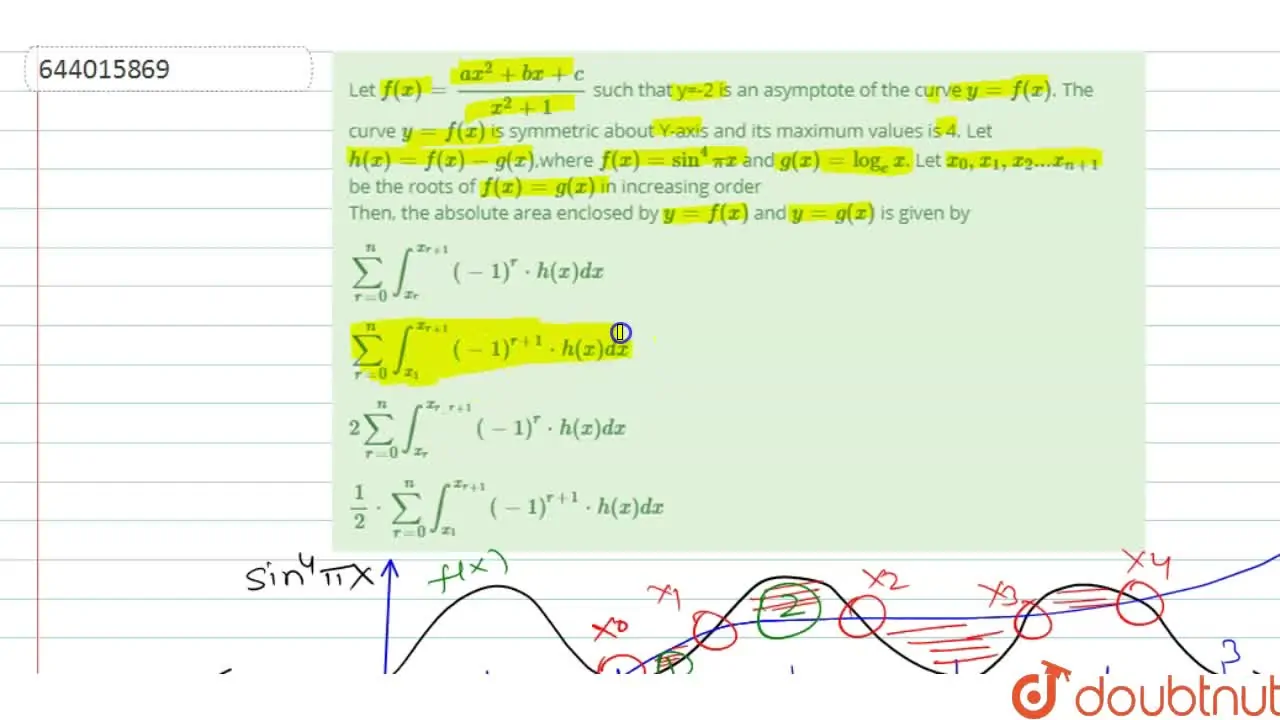Let f(x)=ax2+bx+cx2+1 such that y=-2 is an asymptote of the curve y=f(x). The curve y=f(x) is symmetric about Y-axis and its maximum values is 4. Let h(x)=f(x)−g(x),where f(x)=sin4πx and g(x)=logex. Let x0,x1,x2...xn+1 be the roots of f(x)=g(x) in increasing order
Then, the absolute area enclosed by y=f(x) and y=g(x) is given by
n∑r=0∫xr+1xr(−1)r⋅h(x)dx
n∑r=0∫xr+1x1(−1)r+1⋅h(x)dx
2n∑r=0∫xr_r+1xr(−1)r⋅h(x)dx
12⋅n∑r=0∫xr+1x1(−1)r+1⋅h(x)dx
The correct Answer is:A
Step by step video & image solution for Let f(x)=(ax^2+bx+c)/(x^2+1) such that y=-2 is an asymptote of the curve y=f(x). The curve y=f(x) is symmetric about Y-axis and its maximum values is 4. Let h(x)=f(x)-g(x),where f(x)=sin^4 pi x and g(x)=log_(e)x. Let x_(0),x_(1),x_(2)...x_(n+1) be the roots of f(x)=g(x) in increasing order Then, the absolute area enclosed by y=f(x) and y=g(x) is given by by Maths experts to help you in doubts & scoring excellent marks in Class 12 exams.
Related Playlists
- BOOK - ARIHANT MATHS ENGLISHCHAPTER - AREA OF BOUNDED REGIONSEXERCISE - Area of bounded Regions Exercise 5: Matching Type Questions2videos
AREA OF BOUNDED REGIONS
- BOOK - ARIHANT MATHS ENGLISHCHAPTER - AREA OF BOUNDED REGIONSEXERCISE - Exercise (Single Integer Answer Type Questions)8videos
AREA OF BOUNDED REGIONS
- BOOK - ARIHANT MATHS ENGLISHCHAPTER - AREA OF BOUNDED REGIONSEXERCISE - Exercise (Statement I And Ii Type Questions)5videos
AREA OF BOUNDED REGIONS
- BOOK - ARIHANT MATHS ENGLISHCHAPTER - BIONOMIAL THEOREMEXERCISE - Exercise (Questions Asked In Previous 13 Years Exam)21videos
BIONOMIAL THEOREM
Similar Questions
Let h(x)−f(x)−g(x) where f(x)=sin4πxandg(x)=Inx. Let x0,x1,x2,......,xn−1 be the roots of f(x)=g(x) in increasing oder.Then the absolute area enclosed by y=f(x)andy=g(x) is given by
View SolutionLet h(x)=f(x)=fx−gx, where fx=sin4πx and g(x)=Inx. Let x0,x1,x2,....,xn+1 be the roots of fx=gx in increasing order.
In the above question, the value of n isView SolutionLet f'(x)=sin(x2)andy=f(x2+1) then dydx at x=1 is
View SolutionIf f(x)=x−1 and g(x)=|f|(x)|−2|, then the area bounded by y=g(x) and the curve x2−4y+8=0 is equal to
View SolutionLet f(x)=exsinx , slope of the curve y=f(x) is maximum at x=a if 'a' equals
View SolutionLet y=f(x) such that xy=x+y+1,x∈R−{1}andg(x)=xf(x)
The minimum value of g(x) is:View SolutionLet f(x+y)+f(x−y)=2f(x)f(y)∀x,y∈R and f(0)=k, then
View SolutionLetf(x)=sinx,g(x)=x2 and h(x)=logex.
If F(x)=(hog of )(x), then F''(x) is equal toView SolutionLet f(x)=max{sinx,cosx,12}, then determine the area of region bounded by the curves y=f(x), X-axis, Y-axis and x=2π.
View SolutionLet g(x)=f(f(x)) where f(x)={1+x;0≤x≤2}andf(x)={3−x;2<x≤3} then the number of points of discontinuity of g(x) in [0,3] is :
View Solution


